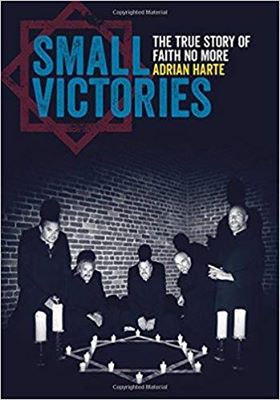In 2009, a website called Faith No More 2.0 launched to share news I never thought I’d hear, mainly that Faith No More had reunited for a European tour. The website promised to inform us fans about any other tidbits they caught wind of. Adrian Harte, the man behind the website, became my go to guy regarding all things FNM. He parsed daily information under the blog heading ”Links for A Day (Cool For A Lifetime)” a nod to the band’s 1995 album King For A Day Fool For A Lifetime. When I took charge of Chuck Mosley’s daily affairs I communicated with Adrian on a regular basis and found a kindred spirit as excited by the band as myself.
As I toured with Chuck, Adrian disclosed he was working on a full book about the band from their earliest days to the present. Released by Jawbone Press in September of 2018, Small Victories: The True Story of Faith No More has become THE guide to my favorite band. I shot Adrian a few questions, and this is what he had to say:
Douglas Esper: Why were you the right person to write this book?
Adrian Harte: Not sure there is anyway of answering this that does not sound pretentious, but I’ll have a go!
I think music biographies require a number of things: good writing, the ability to dig deep in research and ferret out new information, contacts, and a smidgen of fandom. So being a fan of the band (as music writing cannot really be wholly objective), but with the writing, research and analytic skills of a journalist, really helped.
DE: Why did the world need a book about Faith No More?
AH: Not sure if the world needed it, but fans needed it, and I’d argue that the band needed it, and I certainly needed it. The band haven’t really told their own story since 1993, and a lot had happened since then. I wanted to give Faith No More the book I feel they deserved and I hope I did that. On a more esoteric and even morbid level, stories need to be told when they still can be told.
And the world certainly needed a definitive Faith No More more than a new Beatles, Bowie, Dylan or even Metallica book, which what most publishers seem to want to foist on readers.
DE: What was one fact you learned while putting this book together?
AH: That not one but two huge rock stars came close to joining Faith No More at different times.
DE: Have you ever enjoyed a Hamm’s? (The beer made in Faith No More’s early practice space.)
AH: Unfortunately not.
DE: Who did you speak to that changed/informed/strengthened your love of the band?
AH: Everyone I spoke to helped enormously. Speaking to the bad members underlined how much they care about the band and their colleagues, and about the fans. But speaking to the Faith No Man line-up, Wade Worthington and M Morris, was a real privilege. They had nothing to gain from helping out, but did so anyway, and they really heightened the understanding of the band’s early days.
Equally, Chuck Mosley was a delight to speak to, and I’m glad I got some of his voice in the book and helped educate both fans and non-fans about his key role in the band’s story.
Oh, and Matt Wallace’s insights were essential, but his love of the band really came through, and was infectious.
DE: What was one storyline/fact/moment you researched but weren’t able to fit into the narrative?
AH: Stories of some shows and a little detail about the later albums were lost along the way, but I would have needed another few hundred pages to get everything in, and the editors did a wonderful job.
DE: Give us five songs to get to know the band for someone who has never heard Faith No More:
AH: Midlife Crisis
Ashes to Ashes
The Real Thing
Everything’s Ruined
Chinese Arithmetic
DE: Why should a non-Faith No More fan read this book?
AH: The book is written in such a way to appeal to all music lovers. It is an unusual band story that subverts a lot of biography tropes, but, in its way, it tells the story of rock music, ”alternative” music, the then most popular music, in the 1980s and 1990s and beyond.
If you want to know more about Metallica, Soundgarden and Guns N’ Roses, it is here.
How did bands evolve in the 1980s, how did they get signed, how did the record industry work, what happened in the studio or on big stadium tours in the 1990s, how were videos made, and how big a role did MTV play in rock in the 1990s — all questions answered in the book.
And I hope and I think that the individual Faith No More characters are brought to life in such a way as you’ll be rooting for them, and eager to get to know their music.
DE: After reading the reviews and getting tons of feedback from readers do you look at the book differently/would you change anything?
AH: The reviews have been great and very gratifying. The criticism and feedback hasn’t really pointed out anything I was not aware of before, or things that I could conceivably change. I know that, like many of the great albums, the book is front-loaded in going into more detail on the band’s early and peak years. That was intentional, but maybe an updated edition in the future would allow me to focus more on recent times when sufficient time has passed.
DE: What’s next for Adrian Harte?
AH: I’m back to the day job, but I’ve also got the bug for more writing. I may work with a soccer player on his biography next, but I’d like to work on more music writing projects too.






Comments